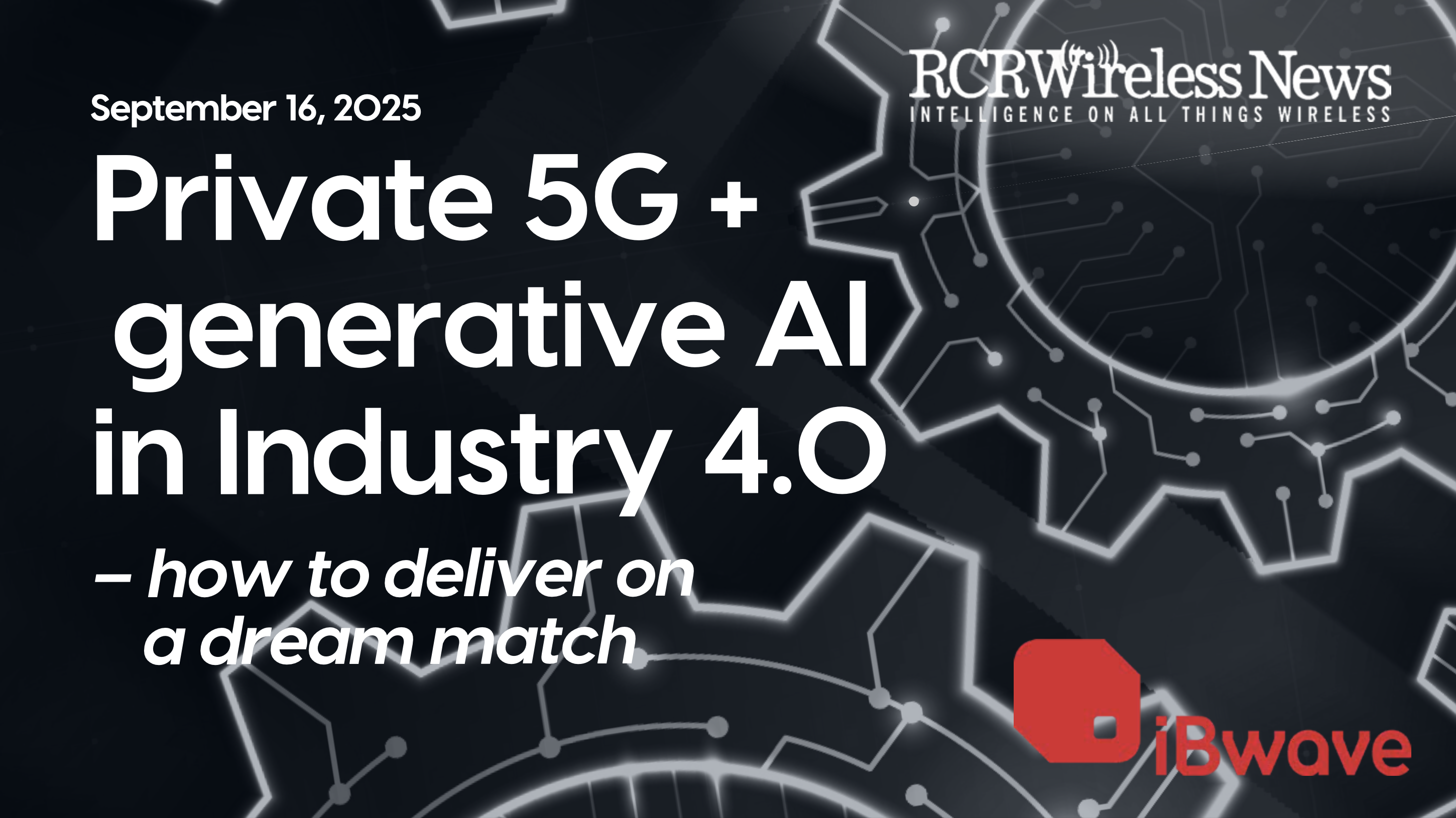Private 5G and generative AI, the twin hype engines of industrial tech, are converging as enabling technologies for Industry 4.0 – driving automation, efficiency, and edge innovation despite differing enterprise priorities.
In sum – what to know:
Combination – 5G and AI are complementary, not dependent, technologies enabling Industry 4.0 growth.
Priorities – enterprises prioritise private 5G for security and reliability; generative AI adoption remains early-stage.
Network – AI increasingly powers network automation, with future convergence expected at the industrial edge.
There is an argument, perhaps, that generative AI and private 5G are the two biggest hype stories in industrial tech right now – going up and down either side of the curve respectively. Maybe that is a telco tale; but private 5G has built a genuine head of steam in Industry 4.0 quarters since the start of the year, to the point large-sized commercial deployments are announced every day, and generative AI is a total phenomenon, of course, going way beyond factory lines, into homes, offices, and the corridors of global power. But the high point for AI, like with 5G, is inside enterprises – where it is required to be customized and dynamic, and where it promises to change the economy.
All of which is why RCR Wireless sought to combine these topics in a webinar last week (available on demand) – to consider how they mesh, and even if they mesh, in service of the broad Industry 4.0 market. So is there a connection between them – really? The panel scratched its collective chin, and the audience wondered out loud – and the response was kind of overwhelming: no; but also yes, everyone agreed. The point is that 5G and AI – whether private and generative, or not – are what engineers and marketers like to call ‘enabling technologies’. One does not beget the other, very clearly; you don’t need 5G for any kind of AI, unless perhaps you are way out in the sticks, and the sums work.
They are horizontal technologies, even when they are privatised and customised for vertical industries; one goes on the other in the classic tech stack – such that their parallel narratives converge at points, as required. Because AI works on 5G, too – maybe less well than on fibre, but then 5G brings mobility, which brings flexibility, which enables certain applications; but probably better than on Wi-Fi, except that Wi-Fi is well-understood, and getting better. In some scenarios, where extensive cabling or coverage is required, 5G is just cheaper, too. And so, by default, AI applications will be attached to 5G networks – as they have been for years (since they were 4G/LTE networks).
You see? There is lots of crossover; it’s just not direct, or implied. During the RCR session, James Moar, principal analyst at Kaleido Intelligence, quoted a company forecast that over $10 billion will be spent on private networks by 2030. Which sounds like a lot, and probably is; growth projections for the private 5G market all spiral upwards, whichever analyst firm you ask. Interestingly, Moar also quoted a company poll of industrial enterprises, which found most are looking for “basic benefits” from private 5G. “They want security, reliability, and privacy,” he said. In other words, generative AI is not a priority for companies looking to roll the device on their own cellular infrastructure.
“About the most exotic thing you get is guaranteed quality-of-service,” he said. “Which is a big feature for network slicing. But that is about as techy as you get. So to drive this market, [there should be a] focus on the very basic side of things, and to build it from there.” Which is a familiar lesson, of course – that enterprises don’t buy tech, only solutions. When the rubber hits the road, anyone selling an industrial version of generative AI will face the same reality-check. The thing is that ‘private 5G’, as it is, is mostly private LTE – in usage, in reality. But the old 80/20 rule will be reversed by 2030, and private 5G SA infrastructure will be commonly deployed in industrial enterprises.
It will be more advanced than in public networks, too; private 5G systems already feature slicing and RedCap, for example, noted Moar. “They were initially built for mission-critical connectivity, but we’re now seeing use cases move beyond that, and other things get attached – so usage is kind of snowballing, if you like. Once the initial ROI is proved, it rapidly becomes something that everyone starts to use – for everything.” And so, suddenly, AI abounds. Right? Well, kind of – this “for-everything” usage is as much about general-purpose IT workloads, he says. At the same time, AI will be everywhere in the network, itself, if not on the network. It is a key distinction.
Moar explained: “AI is a tool for automation within the network itself – which is causing quite radical shifts in how these networks are managed – and they self-organise and self-heal; all these buzzwords come from AI. But the rubber is not hitting the road yet in terms of end user use cases. AI is very much an internal [network] thing in private 5G at the moment.” But we are jumping around, 2025 to 2030, and back again; in five years, AI will be on these networks, too. If enterprises want 5G for privacy, security, and simplicity, when does the conversation about generative AI start? The question goes to Daniel Mai, director of industrial wireless communication at Siemens.
“It has started already,” he says. “But there is no ultimate solution right now – which enterprises can fully rely on. But it is about to happen – to provide assistance to the operations person on the shop floor. Because they know how to brew beer or build a car, but they also need to deal with other technologies – drives, inverters, screens; all sorts of things. And generative AI can bring support to resolve issues more quickly – rather looking things up in a handbook, or relying only on experience. But it is not there yet.” The interest is real in other words; the solution (rather than the background tech) is well perceived, even as it is still being conceived in idiosyncratic industrial domains.
Siemens is investing heavily – in both generative AI and private 5G: its Siemens Industrial Copilot product is a joint venture with Microsoft to tailor generative AI tools for Industry 4.0; it has just paid $10 billion to buy AI simulation software business Altair Engineering; it has built its own industrial-grade private 5G system from scratch. Mai explained: “Future production is about a clean shop floor where things move around. And for that, and for mission-critical applications, you need a capable and reliable communication platform… It is a necessary investment to unlock the potential of AI. Without it, AI and generative AI will not bring [all these things].”
He added: “And it could be all sorts of [connectivity] technologies, but private 5G is a very capable one – especially in industry, where large areas need to be covered, or where cabling in brownfield deployments is quite a rough and expensive job.” The other point, of course, is that AI systems of one kind or another have been attached to industrial networks for years, and more-capable wireless connectivity only accelerates and advances these workloads. Also on the panel, Gary Hill, chief innovation officer at US-based system integrator Future Technologies, made the point that industrial-grade 5G and AI are a “match made at the edge”.
“Both of these are going to run at the edge for industrial clients. [Most] traditional technologies run at the edge – to control manufacturing and safety; not much is going to move off-premise.” There is lots of AI on 5G networks at the sharp end; just no generative AI. Yet. “Most of the bread-and-butter AI use cases we’re working with today – for vision analytics, predictive analytics, vibration analytics – are delivering huge value. We are not seeing as much with the generative AI piece; but it will happen. Same with agentic AI; but that is a bit futuristic as well…. Whereas vision AI is very mature. There are so many things you can do today with vision systems,” said Hill.
“That’s where most of [the action] is… We’ve not implemented generative AI in a production environment for an industrial customer yet. But we see it coming, on private 5G… There’s definitely some interplay at the edge. We’re doing a lot of testing with our network partners and compute vendors, running AI use cases. We have a lot of that in our lab. And our OEM partners are doing lots of innovation with AI to manage and deliver self-healing systems.” Which echoes Moar’s earlier point about how generative AI will appear in private 5G networks before it appears on them. AI will also appear in the tools to design private 5G networks – to support AI applications.
Kelly Burroughs, director of strategy and market development at design software provider iBwave, said: “We are known for its accuracy of simulating network performance. We don’t want to trade off that accuracy, but we are also actively looking at it, and have something in the roadmap.” And in the end, accuracy and trust are everything for Industry 4.0 solutions – which is the challenge, still, with generative AI co-pilots and such, and the reason, actually, original design tools are so crucial.
Burroughs said: “Every time you layer in new AI – whether the robotics or computer vision or futuristic gen AI – puts more pressure on the network. So there is a reality there – that without quality [network design], none of it works. Quality RF equals quality AI; if you have a good RF design then you’re going to maximize your AI outputs.”



